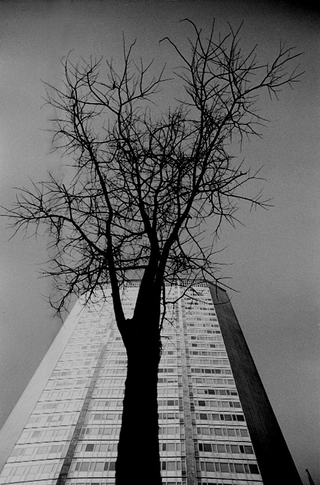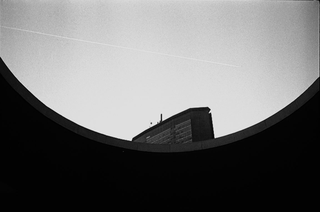"One aspect that consistently emerges from Carlo Orsi’s photographs is his sense of space […] a quality that especially defines the way he observes his Milan. […] In front of Stazione Centrale, he enacts a kind of perspectival revolution by working from top to bottom: he captures the interior with absolute precision, and when he moves outside, he ensures that the shadow of the nearby Pirelli Tower stretches across the square—creating a symbolic dialogue between Ulisse Stacchini’s monumentality and Pier Luigi Nervi’s essentialism. Because Carlo Orsi’s Milan, just like himself, looks to the past without nostalgia and to the future with curiosity."
(Roberto Mutti, “La curiosità come guida”, in Carlo Orsi. Miracoli a Milano, catalogue of the exhibition at Palazzo Morando, Milan, October 31, 2024 - February 2, 2025, eds. Giangiacomo Schiavi and Giovanni Terruzzi [Milan: Moebius 2024], 18)
When Carlo Orsi published his first photography book in 1965—a collection of images of the city of Milan—his storytelling inclination was immediately evident.
The city, his city, is portrayed through a series of photographs rich in expressive intensity, carefully sequenced to construct a narrative. As Gianfranco Pardi wrote: "It is the story, at times dark and dramatic, of a city undergoing profound transformation—a Milan striving, energetically and radically, to emerge from the trauma of the post-war years. During those years, real reconstruction began. For better or worse, everything was changing: new buildings rising, waves of new inhabitants arriving in the first major migratory flows, and everyday habits evolving in the midst of a politically charged atmosphere. Milan was no longer Boccioni’s ‘rising city’—it was a city changing its clothes and character, and that transformation brought dramatic contradictions. This restless motion and its contradictions were captured in Carlo’s book through images that now appear as distilled icons from a complex world of rapidly shifting signs.
The Pirelli skyscraper and the corner tavern were the symbolic extremes of this process—one in which every city dweller, in some way, played an active role. Carlo was photographing the very city he was helping to transform through his lens. In essence, they were beautiful images of his own home, where furniture was being rearranged, a television set bought, and a Filipina housekeeper hired. Images of a world he knew in his youth, a world he took part in—yet one that still awaited discovery and revelation, even though it was 'within reach.'
The streets where Carlo walked, the people he met, the stations from which he so often departed—or arrived."
The Pirelli Skyscraper, also known as the "Pirellone," is one of the landmark buildings of the city of Milan and an icon of Italian architecture. It was commissioned by Pirelli, a leading rubber company, in the 1950s as an expression of the postwar industrial revival and the company's desire to represent, through architecture, the values of innovation, progress and international openness.
Designed by architect Gio Ponti in collaboration with Pier Luigi Nervi, it was built between 1956 and 1960. Ponti's presence can be recognized in the sleek and elegant form, which distances itself from the typical volumes of American skyscrapers due to the tapered silhouette also made possible by the conception of a hexagonal floor plan. Nervi, on the other hand, was responsible for the design of an innovative internal structure: a central core of rigid partitions and tapered pillars, capable of supporting vertical loads and resisting wind, allowing for free and light facades.
The Pirelli Skyscraper, at 127 meters high, was for decades the tallest building in Italy and one of the first reinforced concrete skyscrapers with a thin load-bearing structure.
From 1978 the Region of Lombardy purchased the building from Pirelli, where it moved its offices there, becoming, then, officially operational in the summer of 1980.

"One aspect that consistently emerges from Carlo Orsi’s photographs is his sense of space […] a quality that especially defines the way he observes his Milan. […] In front of Stazione Centrale, he enacts a kind of perspectival revolution by working from top to bottom: he captures the interior with absolute precision, and when he moves outside, he ensures that the shadow of the nearby Pirelli Tower stretches across the square—creating a symbolic dialogue between Ulisse Stacchini’s monumentality and Pier Luigi Nervi’s essentialism. Because Carlo Orsi’s Milan, just like himself, looks to the past without nostalgia and to the future with curiosity."
(Roberto Mutti, “La curiosità come guida”, in Carlo Orsi. Miracoli a Milano, catalogue of the exhibition at Palazzo Morando, Milan, October 31, 2024 - February 2, 2025, eds. Giangiacomo Schiavi and Giovanni Terruzzi [Milan: Moebius 2024], 18)
When Carlo Orsi published his first photography book in 1965—a collection of images of the city of Milan—his storytelling inclination was immediately evident.
The city, his city, is portrayed through a series of photographs rich in expressive intensity, carefully sequenced to construct a narrative. As Gianfranco Pardi wrote: "It is the story, at times dark and dramatic, of a city undergoing profound transformation—a Milan striving, energetically and radically, to emerge from the trauma of the post-war years. During those years, real reconstruction began. For better or worse, everything was changing: new buildings rising, waves of new inhabitants arriving in the first major migratory flows, and everyday habits evolving in the midst of a politically charged atmosphere. Milan was no longer Boccioni’s ‘rising city’—it was a city changing its clothes and character, and that transformation brought dramatic contradictions. This restless motion and its contradictions were captured in Carlo’s book through images that now appear as distilled icons from a complex world of rapidly shifting signs.
The Pirelli skyscraper and the corner tavern were the symbolic extremes of this process—one in which every city dweller, in some way, played an active role. Carlo was photographing the very city he was helping to transform through his lens. In essence, they were beautiful images of his own home, where furniture was being rearranged, a television set bought, and a Filipina housekeeper hired. Images of a world he knew in his youth, a world he took part in—yet one that still awaited discovery and revelation, even though it was 'within reach.'
The streets where Carlo walked, the people he met, the stations from which he so often departed—or arrived."
The Pirelli Skyscraper, also known as the "Pirellone," is one of the landmark buildings of the city of Milan and an icon of Italian architecture. It was commissioned by Pirelli, a leading rubber company, in the 1950s as an expression of the postwar industrial revival and the company's desire to represent, through architecture, the values of innovation, progress and international openness.
Designed by architect Gio Ponti in collaboration with Pier Luigi Nervi, it was built between 1956 and 1960. Ponti's presence can be recognized in the sleek and elegant form, which distances itself from the typical volumes of American skyscrapers due to the tapered silhouette also made possible by the conception of a hexagonal floor plan. Nervi, on the other hand, was responsible for the design of an innovative internal structure: a central core of rigid partitions and tapered pillars, capable of supporting vertical loads and resisting wind, allowing for free and light facades.
The Pirelli Skyscraper, at 127 meters high, was for decades the tallest building in Italy and one of the first reinforced concrete skyscrapers with a thin load-bearing structure.
From 1978 the Region of Lombardy purchased the building from Pirelli, where it moved its offices there, becoming, then, officially operational in the summer of 1980.


Social
Contatti
archivio@carloorsi.com